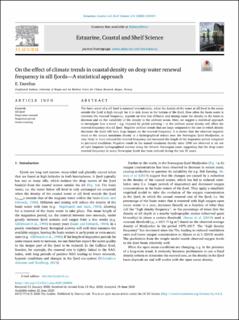On the effect of climate trends in coastal density on deep water renewal frequency in sill fjords—A statistical approach
Journal article, Peer reviewed
Published version

Åpne
Permanent lenke
https://hdl.handle.net/11250/2766141Utgivelsesdato
2020Metadata
Vis full innførselSamlinger
- Geophysical Institute [1198]
- Registrations from Cristin [9791]
Sammendrag
The basin water of a sill fjord is renewed intermittently, when the density of the water at sill level in the ocean outside the fjord is high enough for it to sink down to the bottom of the fjord. How often the basin water is renewed, the renewal frequency, depends on how fast diffusion and mixing cause the density in the basin to decrease and on the variability of the density in the ambient ocean. Here, we suggest a statistical approach to investigate how a trend – e.g. imposed by global warming – in the ambient ocean density will affect the renewal frequency of a sill fjord. Negative ambient trends that are large compared to the rate at which density decreases the fjord will have large impact on the renewal frequency. It is shown that the observed negative trend in the annual maximum density at a hydrographical station near the Norwegian fjord Masfjorden, is very likely to have reduced the renewal frequency and increased the length of the stagnation period compared to pre-trend conditions. Negative trends in the annual maximum density since 1990 are observed at six out of eight longterm hydrographical stations along the Atlantic Norwegian coast, suggesting that the deep water renewal frequency in many Norwegian fjords has been reduced during the last 30 years.
